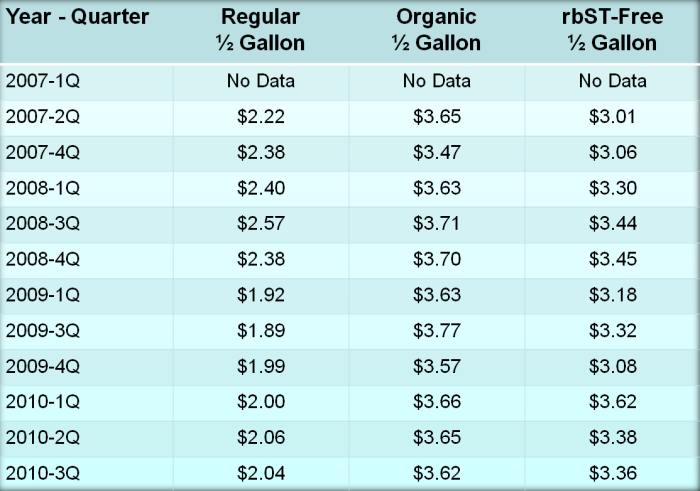Terry D. Etherton
The latest American Farm Bureau Federation Marketbasket Survey of retail food prices was just released. In this informal survey, for the third quarter of 2010, shoppers reported the average price for a half-gallon of regular whole milk was $2.04, down 2 cents from the prior quarter. The average price for one gallon of regular whole milk was $3.16, up 10 cents. Comparing per-quart prices, the retail price for whole milk sold in gallon containers was about 25 percent lower compared to half-gallon containers, a typical volume discount long employed by retailers.
The average price for a half-gallon of rbST-free milk was $3.36, down 2 cents from the last quarter, about 65 percent higher than the reported retail price for a half-gallon of regular milk ($2.04). This price differential (really price gouging) continues the historical trend of dramatically marking up the price of rbST-free milk compared to conventionally-produced milk. The same “old” ploy of charging a lot more for rbST-free milk that is the same from a composition standpoint as conventionally-produced milk.
In this informal survey, the average price for a half-gallon of organic milk was $3.62, down 3 cents compared to the prior quarter–about 80 percent higher than the reported retail price for a half-gallon of regular milk ($2.04).
Compared to a year ago (third quarter of 2009), the retail price for regular milk in gallon containers was up about 10 percent while regular milk in half-gallon containers increased 8 percent. The average retail price for rST-free milk increased about 1 percent in a year’s time. The average retail price for organic milk in half-gallon containers dropped about 4 percent compared to the prior year.
In April, 2008, I had written a blog Food Costs Increase and the “Smoke and Mirrors” of rbST-Free Milk Marketing Rolls On …and On…and On that discussed how many dairy producers using rbST in their herds were getting cheated by being forced to give up the technology, and, yet, the retailers were selling the milk for considerably more. The “historical” milk price data presented in the figure below (Source: American Farm Bureau Federation Marketbasket Survey) show this marketing scheme (i.e., the differential between the price of rbST-free and “regular” milk) continues. Astonishing, isn’t it?


I have also heard many complaints from producers who say that they are forced to stop using the artificial hormone but they are not compensated for the extra cost of production.
Seems extremely unfair. There should be a premium payed to the producer too because he or she is the one that is changing production methods to meet demand. Dairy farmers seem to be powerless in the pricing system.
Farmers in my area are seeing unprecedented input costs and a price of milk that does not give.